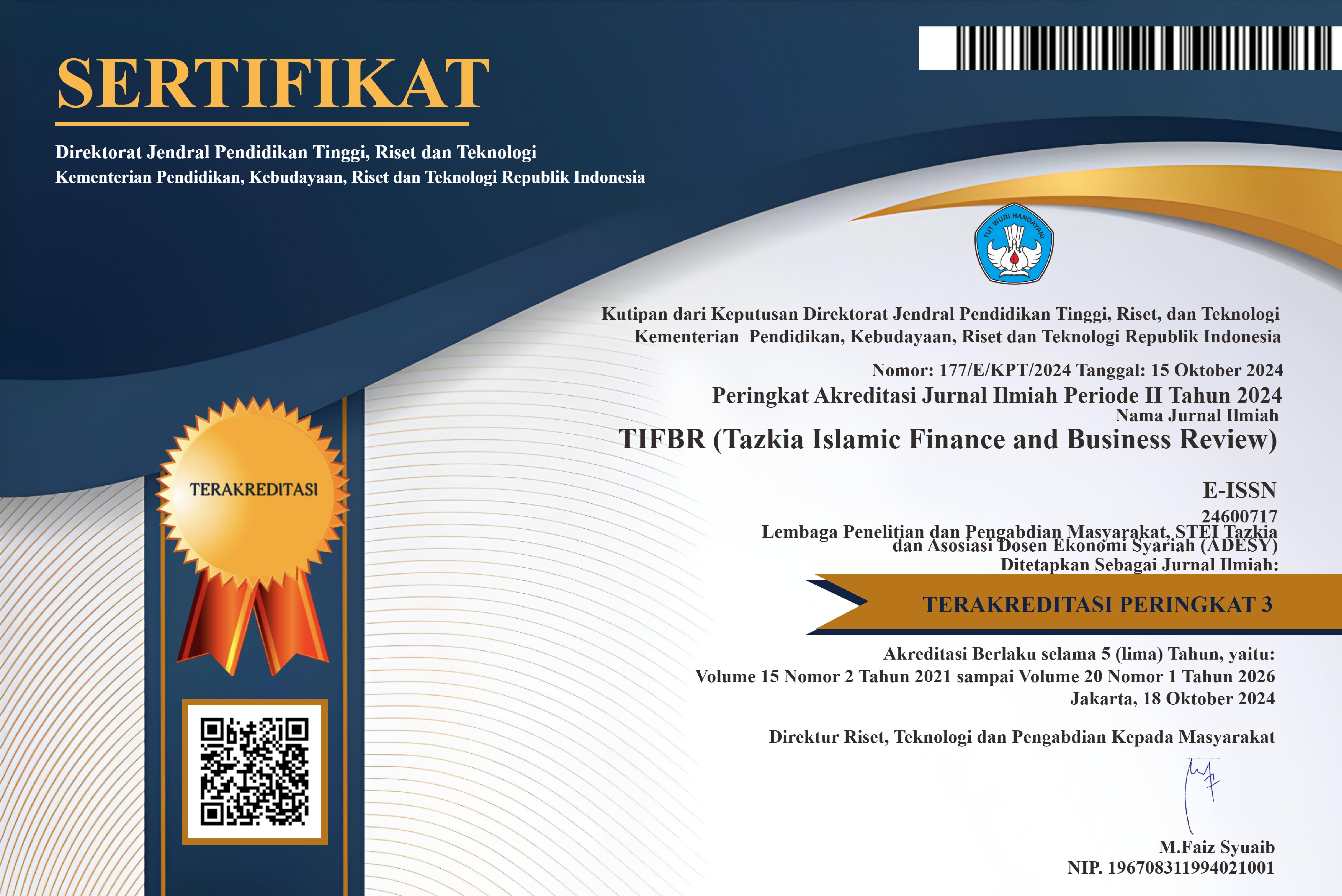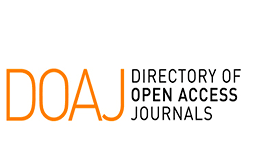THE EPISTEMOLOGICAL PERSPECTIVE OF FRACTIONAL RESERVE BANKING AND FULL RESERVE BANKING: WHERE ISLAMIC BANKING SHOULD STAND?
DOI:
https://doi.org/10.30993/tifbr.v10i1.98Kata Kunci:
Fractional Reserve Banking System, 100% Reserve Banking System, Islamic Banking, EpistemologicalAbstrak
Objectives – this research is aimed to compare those epistemological bases to the mindset of Islamic Bank and try to drive the philosophy in practical operation whether based on the Fractional Reserve Banking Sytem (RBS) or 100% RBS and analyze the challenges in deploying the 100%RBS.
Methods - This research will be conducted based on an extensive literature review.
Results - Based on the epistemological analysis of money and the business cycle as well as the views of Islamic scholars, 100%RBS should be the best for Islamic Bank. There are four types of 100% RBS namely Pure Commodity Money, Sovereign Money, Narrow Banking, and Limited Purpose Banking. To deploy it into the economic system, another philosophical work should be done to choose one of the types and strengthen it so that the theory of 100%RBS can be implemented for the goodness of Islamic Bank.
Conclusion - In Conclusions, Based on the epistemology defined by Islamic Scholars, FractRBS has more mafsadah if we compare to the maslahah. Therefore, 100% RBS should be better for the Islamic Bank.
Referensi
Allen, W. R. (2011). IRVING FISHER AND THE 100 PERCENT RESERVE PROPOSAL *. Journal of Law and Economic, 36(2), 703–717. Retrieved from http://www.jstor.org/stable/725805
Bagus, P. (2012). Austrian Business Cycle Theory: Are 100 Percent Reserves Sufficient to Prevent Business Cycle? Procesos de Mercado: Revista Europa de Economia Politica, IX(1), 389–411.
Bagus, P., & Howden, D. (2009). The Legitimacy of Loan Maturity Mismatching: A Risky, but not Fraudulent, Undertaking. Journal of Business Ethics, 90(3), 399–406. http://doi.org/10.1007/s10551-009-0050-z
Bagus, P., & Howden, D. (2010). Fractional Reserve Free Banking: Some Quibbles. The Quarterly Journal of Austrian Economics, 13(4), 29–56.
Bagus, P., & Howden, D. (2011). Unanswered Quibbles With Fractional Reserve Free Banking. Libertian Papers, 3(18), 1–24.
Barnett II, W., & Block, W. E. (2009). Time Deposits, Dimensions, and Fraud. Journal of Business Ethics, 88, 711–716. http://doi.org/10.1007/s10551-008-9976-9
Bidabad, B. (2013). Stabilizing Business Cycles by PLS Banking and Ethic Economics. Quarterly Economic Journal of Islamic Azad University Iran, 7(24), 37–72.
Carlson, M. A. (2013). Lessons from the Historical Use of Reserve Requirements in the United States to Promote Bank Liquidity Lessons from the Historical Use of Reserve Requirements in the United States to Promote Bank Liquidity (Finance and Economics Discussion Series Divisions of Research & Statistics and Monetary Affairs No. 2013–11). Washington DC.
Cochran, J. P., & Call, S. T. (1998). The Role of Fractional-Reserve Banking and Financial Intermediation in The Money Supply Process: Keynes and The Austrians. The Quarterly Journal of Austrian Economics, 1(3), 29–40.
Cochran, J. P., & Call, S. T. (2000). Free Banking and Credit Creation: Implications for Business Cycle Theory. The Quarterly Journal of Austrian Economics, 3(3), 35–50.
Curott, N. A. (2016). Adam Smith Theory of Money and Banking (No. SAE/No.47/February 2016). Baltimore, Maryland.
De Soto, J. H. (2006). Money, Bank Credit, and Economic Cycles. (M. A. Stroup, Ed.) (English Ed). Auburn, Alabama: Ludwig Von Mises Institute.
Dow, S., Johnsen, G., & Montagnoli, A. (2015). A critique of full reserve banking (Economic Research Paper Series No. SERPS No. 2015008). Sheffield. Retrieved from www.sheffield/economics
Ernst and Young. (2016). World Islamic Banking Competitiveness Report. Retrieved October 24, 2016, from http://www.ey.com/Publication/vwLUAssets/ey-world-islamic-banking-competitiveness-report-2016/$FILE/ey-world-islamic-banking-competitiveness-report-2016.pdf
Furqani, H., & Haneef, A. M. (2013). Theory appraisal in Islamic economic methodology : purposes and criteria. Humanomics, 29(3), 187–201. http://doi.org/10.1108/H-07-2013-0050
García, V. F., Cibils, V. F., & Maino, R. (2004). Remedy For Banking Crises: What Chicago and Islam Have in Common. Islamic Economic Studies, 11(2), 1–22.
Goodhart, C., & Jensen, M. (2015). Currency School versus Banking School : an ongoing confrontation. Economic Thought, 4(2), 20–31.
Hanif, M. (2011). Differences and Similarities in Islamic and Conventional Banking. International Journal of Business and Social Science, 2(2), 166–175.
Hasan, Z. (2011). Money Creation and Control from Islamic Perspective (No. 28366). Munich. Retrieved from http://mpra.ub.uni-muenchen.de/28366/
Hatta, M. F. M., Dien, M. I. D., & Mohammad, S. (2014). Examining the Impact of Islamic Products on Debt Expansion and Inflationary Pressure. International Interdisciplinary Journal of Scientific Research, 1(2), 13–28.
Iqbal, Z., & Mirakhor, A. (2013). Economic Development and Islamic Finance. (A. Mirakhor & Z. Iqbal, Eds.). Washington DC: World Bank: Series on Directions in Development. http://doi.org/10.1596/978-0-8213-9953-8
Ishaq, H. M., & Mahjabeen. (2015). The impact of Fractional Reserve Banking System on the Ownership Structure of Economy. Pakistan Journal of Social Sciences (PJSS), 35(2), 619–628.
Kameel, A., Meera, M., & Larbani, M. (2006). Part I : Seigniorage of fiat money and the maqasid al-Shari â€TM ah : the unattainableness of the maqasid. Humanomics, 22(1), 17–33.
Karim, S. A. (2010). The Islamic Moral Economy A Study of Islamic Money and Financial Instruments. Florida: Brown, Walker Press.
Keister, T., & Mcandrews, J. J. (2009). Why Are Banks Holding So Many Excess Reserves? Current Issues in Economics and Finance, 15(8), 1–10.
Lainà, P. (2015). Money Creation under Full Reserve Banking: Stock Flow Consistent Model (No. 851). New York. Retrieved from http://etdiscussion.worldeconomicsassociation.org/wp-content/uploads/Laina-30-march-15.pdfhttp://etdiscussion.worldeconomicsassociation.org/wp-content/uploads/Laina-30-march-15.pdf
Macovei, M. (2015). The Austrian Business Cycle Theory: A Defense of Its General Validity. The Quarterly Journal of Austrian Economics, 18(4), 409–436.
Mallett, J. (2011). Analyzing the behaviour of the textbook fractional reserve banking model as a complex dynamic system. In Proceedings of the Eighth International Conference on Complex Systems (pp. 1141–1156). New England: New England Complex Systems Institute Series on Complexity. Retrieved from http://necsi.edu/events/iccs2011/papers/60.pdf
Mallett, J. (2015). General Disequilibrium : the Hidden Conflict between Fractional Reserve Banking and Economic Theory. Cosmos + Taxis, 2(2), 18–33. Retrieved from the web: https://reykjavik.academia.edu/jackymallett%0ABio-sketch:
Meera, A., & Larbani, M. (2009). Ownership effects of fractional reserve banking: an Islamic perspective. Humanomics, 25(2), 1–25. http://doi.org/10.1108/08288660910964175
Mirakhor, A. (2009). The Recent Crisis: Lessons For Islamic Economic. (IFSB, Ed.) (2nd Public). Kuala Lumpur: IFSB.
Nair, M. (2013). Fractional Reserves and Demand Deposits : Historical Evidence from an Unregulated Banking System. The Independent Review, 18(1), 77–88.
Nair, M. (2015). Fractional Reserve Banking, Client Collaboration, and Fraud. Journal of Business Ethics, 85–92. http://doi.org/10.1007/s10551-014-2176-x
Nuri, V. Z. (2002). Fractional Reserve Banking as Economic Parasitism. Retrieved from http://www.thetransitioner.org/wiki/tikiindex.php?page=Vladimir+Nuri
Ochaita, A. V. (2010). The Use of The Money In The Deposits Banking. Some Questions of Roman Law Within The Framework of The Present Financial Crisis. Journal of Business Case Studies - Spanish Edition, 6(7), 37–43.
Quinn, S. (1997). Goldsmith-Banking : Mutual Acceptance and Interbanker Clearing in Restoration London. Explorations In Economics History, 34(EH970682), 411–432.
Radelet, S., & Sachs, J. (2000). The Onset of the East Asean Financial Crisis. In P. Krugman (Ed.), Currency Crises (Vol. I, pp. 105–103). Chicago: University Chicago Press. Retrieved from http://www.nber.org/books/krug00-1
Rochet, J. (2003). Why Are There so Many Banking Crises ? CESido Economic Studies, 49(2), 141–143.
Rothbard, M. N. (2008). The Mystery of Banking (Second Edi). Auburn, Alabama: Ludwig Von Mises Institute.
Selgin, G. (2009). 100 Percent Reserve Money: The Small Change Challenge. The Quarterly Journal of Austrian Economics, 1(1), 3–16.
Smolo, E., & Mirakhor, A. (2014). Limited purpose banking ( LPB ) and Islamic finance Could LPB model be applied to Islamic. Humanomics, 30(2), 122–135. http://doi.org/10.1108/H-08-2013-0053
Tanjung, H., & Siregar, H. (2012). Macroeconomic An Evolutionary Approach. Bogor: IPB Press.
Van Dixhorn, C. (2013). Full Reserve Banking: An analysis of four monetary reform plans (April - June 2013). Utrecht.
Wallace, N. (1988). Another Attempt to Explain an Illiquid Banking System: The Diamond and Dybvig Model With Sequential Service Taken Seriously.
Wan Ibrahim, W. H., & Ismail, A. G. (2015). Conventional bank and Islamic banking as institutions : similarities and differences. Humanomics, 31(3), 272–298. http://doi.org/10.1108/H-09-2013-0056
Werner, R. A. (2014). International Review of Financial Analysis Can bank individually create money out of nothing ? — The theories and the empirical evidence ☆, 36, 1–19.
Werner, R. A. (2016). A lost century in economics: Three theories of banking and the conclusive evidence. International Review of Financial Analysis, 46, 361–379. http://doi.org/10.1016/j.irfa.2015.08.014
##submission.downloads##
Diterbitkan
Cara Mengutip
Terbitan
Bagian
Lisensi

Tazkia Islamic Finance and Business Review (TIFBR) is licensed under a Creative Commons Attribution-NonCommercial 4.0 International License.
Authors who publish with this journal agree to the following terms:
- Authors retain copyright and grant the journal right of first publication with the work simultaneously licensed under a Creative Commons Attribution License that allows others to share the work with an acknowledgment of the work's authorship and initial publication in this journal.
- Authors are able to enter into separate, additional contractual arrangements for the non-exclusive distribution of the journal's published version of the work (e.g., post it to an institutional repository or publish it in a book), with an acknowledgment of its initial publication in this journal.
- Authors are permitted and encouraged to post their work online (e.g., in institutional repositories or on their website), as it can lead to productive exchanges, as well as earlier and greater citation of published work (See the Effect of Open Access).

















